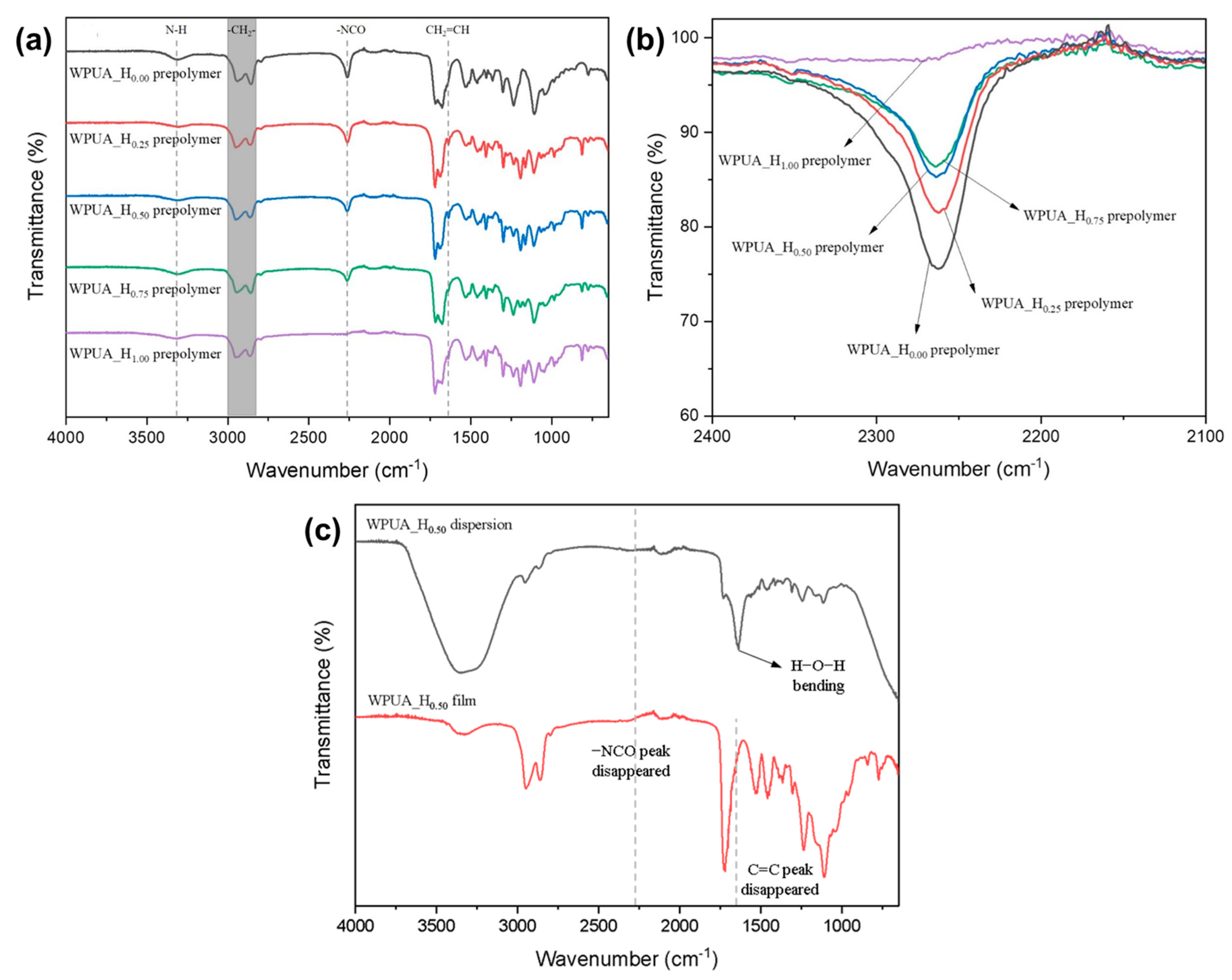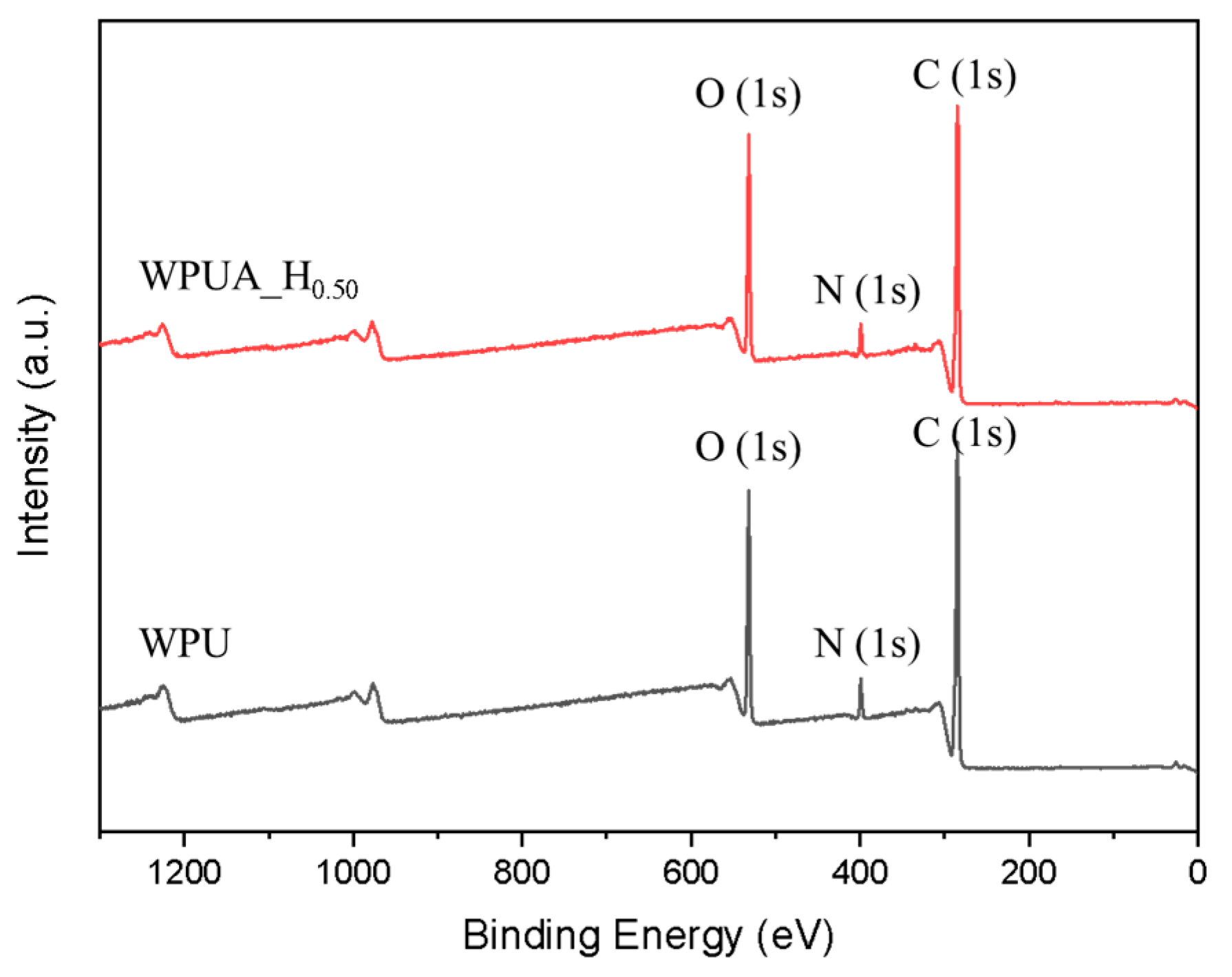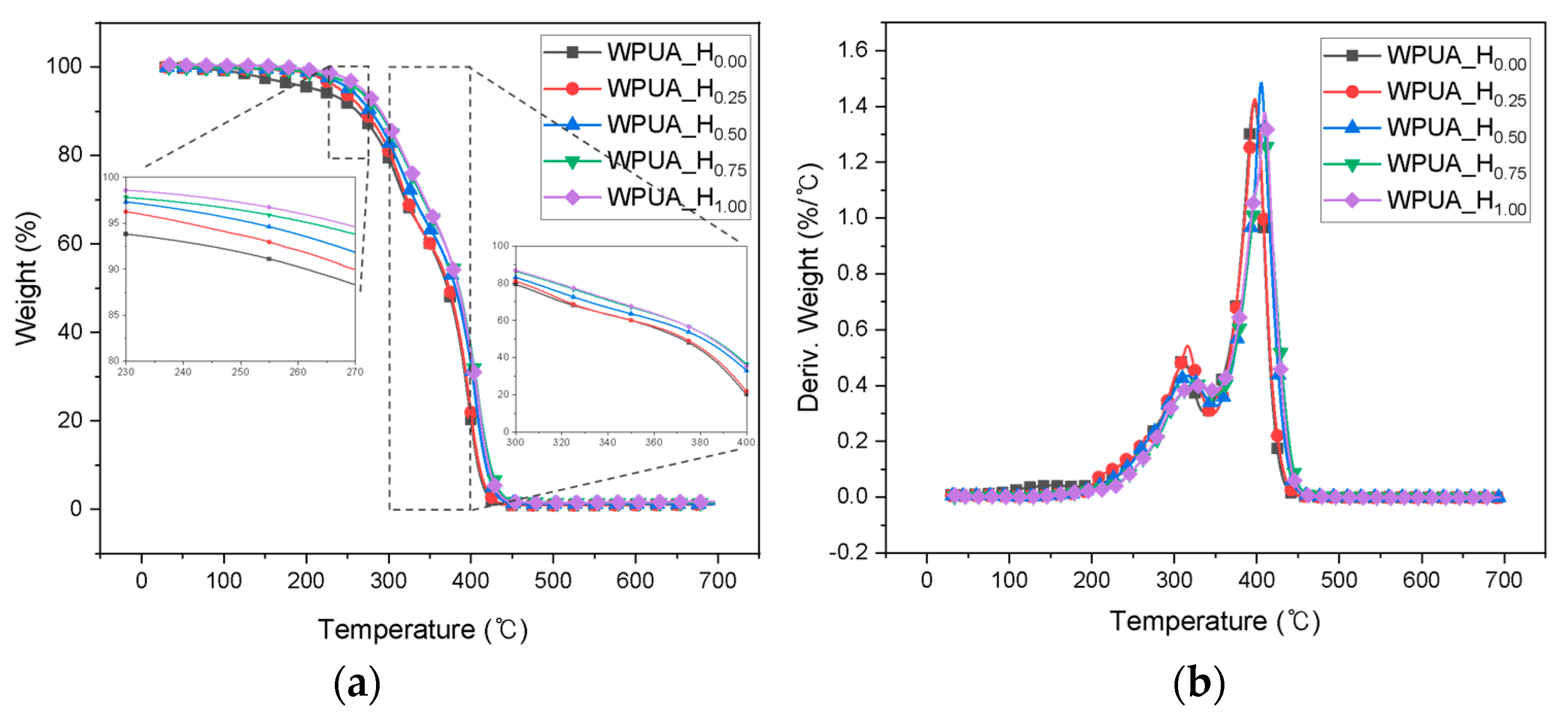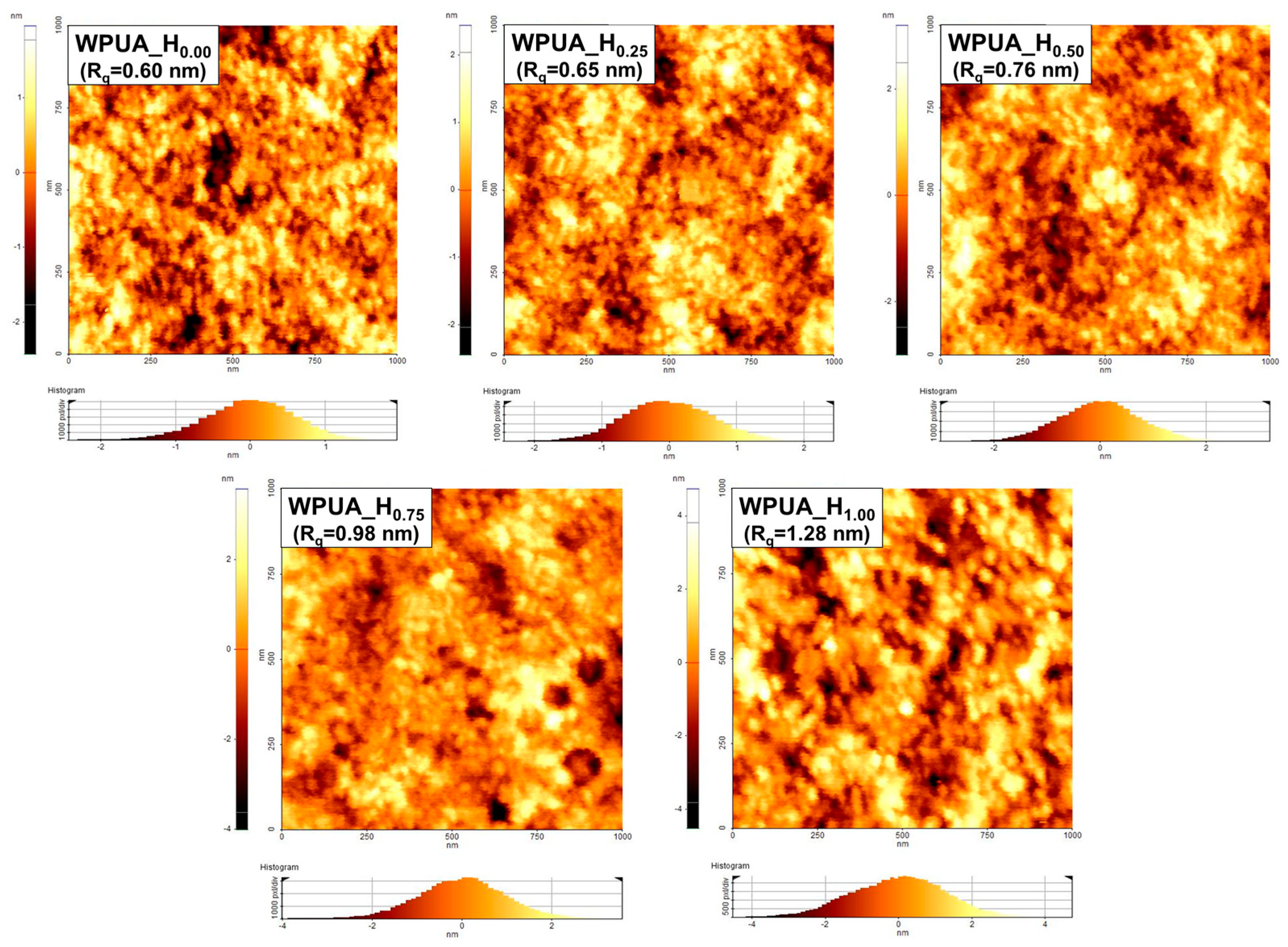Effects of Grafting Degree on the Formation of Waterborne Polyurethane-Acrylate Film with Hard Core–Soft Shell Structure
Abstract
:1. Introduction
2. Experiment
2.1. Materials and Methods
2.2. Preparation of WPUA Samples
2.3. Preparation of WPUA Films
2.4. Characterization
2.4.1. Particle Size Distribution and Zeta Potential
2.4.2. Transmission Electron Microscopy (TEM)
2.4.3. Gel Fraction
2.4.4. XPS
2.4.5. Fourier Transform Infrared Spectroscopy (FT-IR)
2.4.6. MFFT
2.4.7. Dynamic Mechanical Analysis (DMA)
2.4.8. Atomic Force Microscopy (AFM)
2.4.9. Scanning Electron Microscopy (SEM)
2.4.10. Nano-Indentation Test
2.4.11. Cross-Cut Test
2.4.12. Transparency Evaluation
3. Results
3.1. FT-IR Analysis
3.2. Particle Size and Gel Fraction of WPUA Latex
3.3. Characterization of Core-Shell Structure
3.4. Viscoelastic and Thermal Characterization of WPUA Films
3.5. Morphological Characteristics of WPUA Films
3.6. Mechanical and Optical Properties
4. Conclusions
Author Contributions
Funding
Institutional Review Board Statement
Data Availability Statement
Conflicts of Interest
References
- Jiménez-López, A.M.; Hincapié-Llanos, G.A. Identification of Factors Affecting the Reduction of VOC Emissions in the Paint Industry: Systematic Literature Review-SLR. Prog. Org. Coat. 2022, 170, 106945. [Google Scholar] [CrossRef]
- Ifijen, I.H.; Maliki, M.; Odiachi, I.J.; Aghedo, O.N.; Ohiocheoya, E.B. Review on Solvents Based Alkyd Resins and Water Borne Alkyd Resins: Impacts of Modification on Their Coating Properties. Chem. Afr. 2022, 5, 211–225. [Google Scholar] [CrossRef]
- Steward, P.A.; Hearn, J.; Wilkinson, M.C. An Overview of Polymer Latex Film Formation and Properties. Adv. Colloid Interface Sci. 2000, 86, 195–267. [Google Scholar] [CrossRef] [PubMed]
- Brito, E.L.; Ballard, N. Film Formation of Hard-Core/Soft-Shell Latex Particles. J. Polym. Sci. 2022, 61, 410–421. [Google Scholar] [CrossRef]
- Berce, P.; Skale, S.; Razboršek, T.; Slemnik, M. Influence of Coalescing Aids on the Latex Properties and Film Formation of Waterborne Coatings. J. Appl. Polym. Sci. 2017, 134, 45142. [Google Scholar] [CrossRef]
- Berce, P.; Skale, S.; Slemnik, M. Electrochemical Impedance Spectroscopy Study of Waterborne Coatings Film Formation. Prog. Org. Coat. 2015, 82, 1–6. [Google Scholar] [CrossRef]
- Limousin, E.; Ballard, N.; Asua, J.M. Soft Core-Hard Shell Latex Particles for Mechanically Strong VOC-Free Polymer Films. J. Appl. Polym. Sci. 2019, 136, 47608. [Google Scholar] [CrossRef]
- Dron, S.M.; Bohorquez, S.J.; Mestach, D.; Paulis, M. Reducing the Amount of Coalescing Aid in High Performance Waterborne Polymeric Coatings. Eur. Polym. J. 2022, 170, 111175. [Google Scholar] [CrossRef]
- Yuan, X.; Huo, D.; Qian, Q. Effect of Annealing on the Phase Structure and the Properties of the Film Formed from P(St-Co-BA)/P(MMA-Co-BA) Composite Latex. J. Colloid Interface Sci. 2010, 346, 72–78. [Google Scholar] [CrossRef]
- Hasanzadeh, I.; Mahdavian, A.R.; Salehi-Mobarakeh, H. Particle Size and Shell Composition as Effective Parameters on MFFT for Acrylic Core–Shell Particles Prepared via Seeded Emulsion Polymerization. Prog. Org. Coat. 2014, 77, 1874–1882. [Google Scholar] [CrossRef]
- Akindoyo, J.O.; Beg, M.D.H.; Ghazali, S.; Islam, M.R.; Jeyaratnam, N.; Yuvaraj, A.R. Polyurethane Types, Synthesis and Applications—A Review. RSC Adv. 2016, 6, 114453–114482. [Google Scholar] [CrossRef]
- Wang, L.; Zhu, Y.; Qu, J. Preparation and Assistant-Film-Forming Performance of Aqueous Polyurethane Dispersions. Prog. Org. Coat. 2017, 105, 9–17. [Google Scholar] [CrossRef]
- Yang, J.; Winnik, M.A.; Ylitalo, D.; DeVoe, R.J. Polyurethane−Polyacrylate Interpenetrating Networks. 1. Preparation and Morphology. Macromolecules 1996, 29, 7047–7054. [Google Scholar] [CrossRef]
- Mehravar, S.; Ballard, N.; Tomovska, R.; Asua, J.M. Polyurethane/Acrylic Hybrid Waterborne Dispersions: Synthesis, Properties and Applications. Ind. Eng. Chem. Res. 2019, 58, 20902–20922. [Google Scholar] [CrossRef]
- Peruzzo, P.J.; Anbinder, P.S.; Pardini, O.R.; Vega, J.; Costa, C.A.; Galembeck, F.; Amalvy, J.I. Waterborne Polyurethane/Acrylate: Comparison of Hybrid and Blend Systems. Prog. Org. Coat. 2011, 72, 429–437. [Google Scholar] [CrossRef]
- Xu, H.; Qiu, F.; Wang, Y.; Yang, D.; Wu, W.; Chen, Z.; Zhu, J. Preparation, Mechanical Properties of Waterborne Polyurethane and Crosslinked Polyurethane-Acrylate Composite. J. Appl. Polym. Sci. 2011, 124, 958–968. [Google Scholar] [CrossRef]
- Bizet, B.; Grau, E.; Cramail, H.; Asua, J.M. Crosslinked isocyanate-free poly(hydroxy urethane) s–Poly(butyl methacrylate) hybrid latexes. Eur. Polym. J. 2021, 146, 110254. [Google Scholar] [CrossRef]
- Dong, A.; An, Y.; Feng, S.; Sun, D. Preparation and morphology studies of core-shell type waterborne polyacrylate–polyurethane microspheres. J. Colloid Interface Sci. 1999, 214, 118–122. [Google Scholar] [CrossRef]
- Kim, B.K.; Lee, J.C. Modification of waterborne polyurethanes by acrylate incorporations. J. Appl. Polym. Sci. 1995, 58, 1117–1124. [Google Scholar] [CrossRef]
- Zhu, Z.; Li, R.; Zhang, C.; Gong, S. Preparation and properties of high solid content and low viscosity waterborne polyurethane—Acrylate emulsion with a reactive emulsifier. Polymers 2018, 10, 154. [Google Scholar] [CrossRef]
- ASTM D2354; Standard Test Method for Minimum Film Formation Temperature (MFFT) of Emulsion Vehicles. ASTM International: West Conshohocken, PA, USA, 2018.
- ASTM D1474; Standard Test Methods for Indentation Hardness of Organic Coatings. ASTM International: West Conshohocken, PA, USA, 2008.
- ISO 2409:2020; Paints and varnishes—Cross-cut test. International Organization for Standardization: Geneva, Switzerland, 2020.
- Xu, J.; Jiang, Y.; Qiu, F.; Dai, Y.; Yang, D.; Yu, Z.; Yang, P. Synthesis, Mechanical Properties and Iron Surface Conservation Behavior of UV-Curable Waterborne Polyurethane-Acrylate Coating Modified with Inorganic Carbonate. Polym. Bull. 2018, 75, 4713–4734. [Google Scholar] [CrossRef]
- Jang, T.; Kim, H.J.; Jang, J.B.; Kim, T.H.; Lee, W.; Seo, B.; Ko, W.B.; Lim, C.S. Synthesis of Waterborne Polyurethane Using Phosphorus-Modified Rigid Polyol and Its Physical Properties. Polymers 2021, 13, 432. [Google Scholar] [CrossRef] [PubMed]
- Wang, W.; Li, L.; Jin, S.; Wang, Y.; Lan, G.; Chen, Y. Study on Cellulose Acetate Butyrate/Plasticizer Systems by Molecular Dynamics Simulation and Experimental Characterization. Polymers 2020, 12, 1272. [Google Scholar] [CrossRef] [PubMed]
- Yen, F.S.; Hong, J.L. Hydrogen-Bond Interactions between Ester and Urethane Linkages in Small Model Compounds and Polyurethanes. Macromolecules 1997, 30, 7927–7938. [Google Scholar] [CrossRef]
- Kamoun, E.A.; El-Betany, A.; Menzel, H.; Chen, X. Influence of Photoinitiator Concentration and Irradiation Time on the Crosslinking Performance of Visible-Light Activated Pullulan-HEMA Hydrogels. Int. J. Biol. Macromol. 2018, 120, 1884–1892. [Google Scholar] [CrossRef] [PubMed]
- Cakić, S.M.; Špírková, M.; Ristić, I.S.; B-Simendić, J.K.; Milena, M.; Poręba, R. The Waterborne Polyurethane Dispersions Based on Polycarbonate Diol: Effect of Ionic Content. Mater. Chem. Phys. 2013, 138, 277–285. [Google Scholar] [CrossRef]
- Zhang, Q.; Deng, Y.; Fu, Z.; Zhang, H. Effects of the molecular structure on the vibration reduction and properties of hyperbranched waterborne polyurethane–acrylate for damping coatings. J. Appl. Polym. Sci. 2019, 136, 47733. [Google Scholar] [CrossRef]
- Dai, Q.; Wu, D.; Zhang, Z.; Ye, Q. Preparation of monodisperse poly (methyl methacrylate) particles by radiation-induced dispersion polymerization using vinyl terminus polysiloxane macromonomer as a polymerizable stabilizer. Polymer 2003, 44, 73–77. [Google Scholar] [CrossRef]
- Liu, B.L.; Zhang, B.T.; Cao, S.S.; Deng, X.B.; Hou, X.; Chen, H. Preparation of the stable core–shell latex particles containing organic-siloxane in the shell. Prog. Org. Coat. 2008, 61, 21–27. [Google Scholar] [CrossRef]
- Brouwer, W.M. Comparative methods for the characterization of core—Shell latex particles. Colloid Surf. 1989, 40, 235–247. [Google Scholar] [CrossRef]
- Lei, L.; Xia, Z.; Ou, C.; Zhang, L.; Zhong, L. Effects of crosslinking on adhesion behavior of waterborne polyurethane ink binder. Prog. Org. Coat. 2015, 88, 155–163. [Google Scholar] [CrossRef]
- Chattopadhyay, D.K.; Sreedhar, B.; Raju, K.V. Effect of chain extender on phase mixing and coating properties of polyurethane ureas. Ind. Eng. Chem. Res. 2005, 44, 1772–1779. [Google Scholar] [CrossRef]
- Yang, W.; Cheng, X.; Wang, H.; Liu, Y.; Du, Z. Surface and Mechanical Properties of Waterborne Polyurethane Films Reinforced by Hydroxyl-Terminated Poly(Fluoroalkyl Methacrylates). Polymer 2017, 133, 68–77. [Google Scholar] [CrossRef]
- Satguru, R.; Mcmahon, J.; Padget, J.C.; Coogan, R.G. Aqueous Polyurethanes: Polymer Colloids with Unusual Colloidal, Morphological, and Application Characteristics. J. Coat. Technol. 1994, 66, 47–55. [Google Scholar]
- Deng, Y.; Zhou, C.; Zhang, Q.; Zhang, M.; Zhang, H. Structure and performance of waterborne polyurethane-acrylate composite emulsions for industrial coatings: Effect of preparation methods. Colloid Polym. Sci. 2020, 298, 139–149. [Google Scholar] [CrossRef]
- Alvarez, G.A.; Fuensanta, M.; Orozco, V.H.; Giraldo, L.F.; Martín-Martínez, J.M. Hybrid waterborne polyurethane/acrylate dispersion synthesized with bisphenol A-glicidylmethacrylate (Bis-GMA) grafting agent. Prog. Org. Coat. 2018, 118, 30–39. [Google Scholar] [CrossRef]
- Bano, S.; Iqbal, T.; Ramzan, N.; Farooq, U. Study of Surface Mechanical Characteristics of ABS/PC Blends Using Nanoindentation. Processes 2021, 9, 637. [Google Scholar] [CrossRef]
- Chen, Y.; Pan, M.; Li, Y.; Xu, J.Z.; Zhong, G.J.; Ji, X.; Yan, Z.; Li, Z.M. Core-shell nanoparticles toughened polylactide with excellent transparency and stiffness-toughness balance. Compos. Sci. Technol. 2018, 164, 168–177. [Google Scholar] [CrossRef]
- Luo, H.; Wei, H.; Wang, Z.; Li, H.; Chen, Y.; Xiang, J.; Fan, H. Fabrication of UV-curable waterborne polyurethane coatings with self-cleaning, anti-graffiti performance, and corrosion resistance. Colloid Surf. A-Physicochem. Eng. Asp. 2023, 676, 132177. [Google Scholar] [CrossRef]
- Desai, S.; Thakore, I.M.; Brennan, A.; Devi, S. Thermomechanical properties and morphology of interpenetrating polymer networks of polyurethane–poly(methyl methacrylate). J. Appl. Polym. Sci. 2002, 83, 1576–1585. [Google Scholar] [CrossRef]









| Sample | HEMA (mmol) | EDA (mmol) | OHHEMA/NCOPUpre (mol Ratio) |
|---|---|---|---|
| WPUA_H0.00 | 0 | 30 | 0 |
| WPUA_H0.25 | 15 | 22.5 | 0.25 |
| WPUA_H0.50 | 30 | 15 | 0.50 |
| WPUA_H0.75 | 45 | 7.5 | 0.75 |
| WPUA_H1.00 | 60 | 0 | 1.00 |
| Sample | Gel Fraction (%) | Particle Size (nm) | Zeta Potential (mV) |
|---|---|---|---|
| WPUA_H0.00 | 0 | 64.2 | −72.4 |
| WPUA_H0.25 | 5.8 | 70.5 | −52.3 |
| WPUA_H0.50 | 27.7 | 77.1 | −42.9 |
| WPUA_H0.75 | 53.1 | 84.5 | −38.4 |
| WPUA_H1.00 | 86.2 | 92.9 | −35.2 |
| Sample | Tg, PU (°C) | Tg, PA (°C) | υe × 103 (mol/cm3) | MFFT (°C) |
|---|---|---|---|---|
| WPUA_H0.00 | −6.6 | 88.7 | 0.16 | 8.4 |
| WPUA_H0.25 | 2.9 | 77.2 | 0.23 | 11.6 |
| WPUA_H0.50 | 7.7 | 71.5 | 0.83 | 19.2 |
| WPUA_H0.75 | 8.0 | 68.5 | 1.09 | 29.7 |
| WPUA_H1.00 | 53.4 | 1.35 | 42.2 | |
| Sample | HITa (MPa) | EITa (GPa) | Adhesion b | Transmittance c (%) |
|---|---|---|---|---|
| WPUA_H0.00 | 63.0 ± 2.2 | 3.1 ± 0.1 | 5B | 74 ± 2 |
| WPUA_H0.25 | 84.9 ± 2.4 | 3.5 ± 0.1 | 5B | 88 ± 2 |
| WPUA_H0.50 | 86.4 ±3.2 | 3.5 ± 0.2 | 4B | 90 ± 3 |
| WPUA_H0.75 | 89.5 ± 4.7 | 3.8 ± 0.3 | 3B | 91 ± 3 |
| WPUA_H1.00 | 67.5 ± 5.1 | 2.9 ± 0.4 | 2B | 87 ± 5 |
Disclaimer/Publisher’s Note: The statements, opinions and data contained in all publications are solely those of the individual author(s) and contributor(s) and not of MDPI and/or the editor(s). MDPI and/or the editor(s) disclaim responsibility for any injury to people or property resulting from any ideas, methods, instructions or products referred to in the content. |
© 2023 by the authors. Licensee MDPI, Basel, Switzerland. This article is an open access article distributed under the terms and conditions of the Creative Commons Attribution (CC BY) license (https://creativecommons.org/licenses/by/4.0/).
Share and Cite
Kwon, Y.R.; Moon, S.K.; Kim, H.C.; Kim, J.S.; Kwon, M.; Kim, D.H. Effects of Grafting Degree on the Formation of Waterborne Polyurethane-Acrylate Film with Hard Core–Soft Shell Structure. Polymers 2023, 15, 3765. https://doi.org/10.3390/polym15183765
Kwon YR, Moon SK, Kim HC, Kim JS, Kwon M, Kim DH. Effects of Grafting Degree on the Formation of Waterborne Polyurethane-Acrylate Film with Hard Core–Soft Shell Structure. Polymers. 2023; 15(18):3765. https://doi.org/10.3390/polym15183765
Chicago/Turabian StyleKwon, Yong Rok, Seok Kyu Moon, Hae Chan Kim, Jung Soo Kim, Miyeon Kwon, and Dong Hyun Kim. 2023. "Effects of Grafting Degree on the Formation of Waterborne Polyurethane-Acrylate Film with Hard Core–Soft Shell Structure" Polymers 15, no. 18: 3765. https://doi.org/10.3390/polym15183765
APA StyleKwon, Y. R., Moon, S. K., Kim, H. C., Kim, J. S., Kwon, M., & Kim, D. H. (2023). Effects of Grafting Degree on the Formation of Waterborne Polyurethane-Acrylate Film with Hard Core–Soft Shell Structure. Polymers, 15(18), 3765. https://doi.org/10.3390/polym15183765








